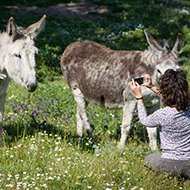Agouti feeding in the burrow
RZSS study reveals secretive animals to be ecosystem engineers
A South American project into the giant armadillo has unearthed the mysterious creature’s role as ecosystems engineers, giving housing and shelter to other species.
The project, undertaken by the Royal Zoological Society of Scotland’s (RZSS) regional coordinator for Latin America, Dr Arnaud Desbiez, is a partnership between RZSS, Brazilian company IPÊ – Institute for Ecological Research, and a private cattle ranch (Baía des Pedras).
According to RZSS, the giant armadillo is very secretive and the first ever photograph was only taken two years ago, followed by a successful shot of a giant armadillo young earlier this year.
Researchers in Brazil have now been able to publish a paper describing the role of giant armadillos as ecosystem engineers. According to their research, the armadillos regularly dig deep burrows, which provide new habitats and influence resources for many other animals.
The project used camera traps in the Brazilian Pantanel and has photographed over 24 different species including lizards, feral pigs and the crab eating fox using the burrows as either a thermal refuge, shelter against predators, feeding ground or a resting spot.
Dr Arnaud Desbiez, Project Coordinator, said: “It’s amazing to see that such a secretive species which occurs at such low densities can play such an important role within the ecological community.”
“The role of this poorly known species as ecosystem engineer may be of high value to the community of vertebrates in the Pantanel and other regions in its extensive range. Giant armadillos are found throughout most of South America and in a diversity of biomes.”
The giant armadillo is threatened with extinction and is currently classified as vulnerable. It is thought that their burrows will only further aid animals as the impact of climate change increases.
Although rarely seen, the giant armadillo plays a key role in the ecological community of South America and deserves to be better understood and protected.
Image courtesy of the Pantanel Giant Armadillo Project






 RCVS Knowledge has called on vet practices to audit their post-operative neutering outcomes.
RCVS Knowledge has called on vet practices to audit their post-operative neutering outcomes.
